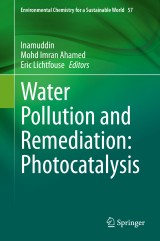Details

Water Pollution and Remediation: Photocatalysis
Environmental Chemistry for a Sustainable World, Band 57
|
181,89 € |
|
| Verlag: | Springer |
| Format: | |
| Veröffentl.: | 29.10.2020 |
| ISBN/EAN: | 9783030547233 |
| Sprache: | englisch |
Dieses eBook enthält ein Wasserzeichen.
Beschreibungen
In the context of climate change and fossil fuel pollution, solar energy appears as a cheap and sustainable fuel for many environmental applications, yet the efficiency of techniques has to be improved. This book reviews recent methods and applications of photocatalysis for the treatment of wastewater containing bacteria, heavy metals, organic pollutants, dyes and tannery effluents. Basics of water pollution, polluted river ecosystems and membranes are also detailed.
<p>Chapter 01 Photocatalytic Remediation of Organic Pollutants in Waste.- Chapter 02 Carbon Nitride/Metal Oxide Hybrids for Visible Light Harvesting and Water Remediation.- Chapter 03 Metal and Carbon Quantum Dots Photocatalysts for Water Purification.- Chapter 04 Photocatalytic Degradation of Azo Dyes in Water.- Chapter 05 Sonochemical Treatment of Textile Wastewater.- Chapter 06 Degradation Mechanism of Pollutants using Sono-Hybrid Advanced Oxidation Processes.- Chapter 07 Photocatalytic Nanomaterials for Bacterial Disinfection.- Chapter 08 Role of Membranes in Wastewater Treatment.- Chapter 09 Nanomaterials for the Photoremediation of Pollutants.- Chapter 10 Bismuth-Based Compounds as Visible Light Photocatalyst for Remediation and Water Splitting.- Chapter 11 Solar Photocatalytic Treatment of Tannery Effluents.- Chapter 12 Functionalized Ionic Liquids for fhe Photodegradation of Dyes.- Chapter 13 Photocatalytic Degradation of Chlorophenols and Antibiotics from Wastewater.</p>
<p><b>Dr. Inamuddin, </b>is an assistant professor in the Chemistry Department, King Abdulaziz University, Jeddah, Saudi Arabia and is also an assistant professor in the Department of Applied Chemistry, Aligarh Muslim University, Aligarh, India. He has extensive research experience in multidisciplinary fields of analytical chemistry, materials chemistry, electrochemistry, renewable energy and environmental science. He has published about 162 research articles in various international scientific journals, 18 book chapters, and 96 edited books with multiple well-known publishers. His current research interests include ion exchange materials, a sensor for heavy metal ions, biofuel cells, supercapacitors and bending actuators.<b></b></p>
<p><b>Dr. Mohd Imran Ahamed</b> received his Ph.D degree on the topic "Synthesis and characterization of inorganic-organic composite heavy metals selective cation-exchangers and their analytical applications", from Aligarh Muslim University, Aligarh, India in 2019. He has published several research and review articles in the journals of international recognition. He has also edited various books which are published by Springer, CRC Press Taylor & Francis Asia Pacific and Materials Science Forum LLC, U.S.A. He has completed his B.Sc. (Hons) Chemistry from Aligarh Muslim University, Aligarh, India, and M.Sc. (Organic Chemistry) from Dr. Bhimrao Ambedkar University, Agra, India. His research work includes ion-exchange chromatography, wastewater treatment, and analysis, bending actuator and electrospinning.</p>
<b>Dr. Eric Lichtfouse</b> is a biogeochemist at Aix Marseille University who has invented carbon-13 dating, a molecular-level method allowing to study the dynamics of organic compounds in temporal pools of complex environmental media. He is Chief Editor of the journal Environmental Chemistry Letters, and the book series Sustainable Agriculture Reviews and Environmental Chemistry for a Sustainable World. He is the author of the book Scientific Writing for Impact Factor Journals, which includes an innovative writing tool: the Micro-Article.
<p><b>Dr. Mohd Imran Ahamed</b> received his Ph.D degree on the topic "Synthesis and characterization of inorganic-organic composite heavy metals selective cation-exchangers and their analytical applications", from Aligarh Muslim University, Aligarh, India in 2019. He has published several research and review articles in the journals of international recognition. He has also edited various books which are published by Springer, CRC Press Taylor & Francis Asia Pacific and Materials Science Forum LLC, U.S.A. He has completed his B.Sc. (Hons) Chemistry from Aligarh Muslim University, Aligarh, India, and M.Sc. (Organic Chemistry) from Dr. Bhimrao Ambedkar University, Agra, India. His research work includes ion-exchange chromatography, wastewater treatment, and analysis, bending actuator and electrospinning.</p>
<b>Dr. Eric Lichtfouse</b> is a biogeochemist at Aix Marseille University who has invented carbon-13 dating, a molecular-level method allowing to study the dynamics of organic compounds in temporal pools of complex environmental media. He is Chief Editor of the journal Environmental Chemistry Letters, and the book series Sustainable Agriculture Reviews and Environmental Chemistry for a Sustainable World. He is the author of the book Scientific Writing for Impact Factor Journals, which includes an innovative writing tool: the Micro-Article.
In the context of climate change and fossil fuel pollution, solar energy appears as a cheap and sustainable fuel for many environmental applications, yet the efficiency of techniques has to be improved. This book reviews recent methods and applications of photocatalysis for the treatment of wastewater containing bacteria, heavy metals, organic pollutants, dyes and tannery effluents. Basics of water pollution, polluted river ecosystems and membranes are also detailed.
Outlines the approaches used for wastewater treatment using solar driven photocatalysis Summarizes the latest information for the photocatalytic treatment of various types of pollutants Gives fundamental and mechanistic overviews of various topics

















